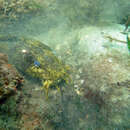fr
noms dans le fil d’Ariane


Cnidoglanis macrocephalus és una espècie de peix de la família dels plotòsids i de l'ordre dels siluriformes.
Els adults mengen principalment mol·luscs i poliquets.[7]
És depredat per Platycephalus speculator, Pelecanus conspicillatus, Phalacrocorax carbo, Phalacrocorax melanoleucos i Phalacrocorax varius.[8][9]
És un peix demersal i de clima temperat que viu fins als 30 m de fondària.[6]
És un endemisme d'Austràlia.[6][10][11][12][13]
Pot arribar a viure 13 anys.[7]
La presència d'espines esmolades a les aletes dorsal i pectoral poden infligir ferides doloroses.[14]
Cnidoglanis macrocephalus és una espècie de peix de la família dels plotòsids i de l'ordre dels siluriformes.
Cnidoglanis macrocephalus is a species of catfish (order Siluriformes) of the family Plotosidae, and is the only species of the genus Cnidoglanis.[1] It is commonly known as the cobbler, estuary cobbler, deteira, estuary catfish, South Australian catfish, or Swan River catfish.[2][3]
The cobbler is found from Main Beach, Queensland to Jervis Bay, New South Wales, and Kingston SE, South Australia to Houtman Abrolhos Islands, Western Australia and Duck River, Tasmania, in near-shore and reef habitats.[1]
Like other eeltail catfish, the cobbler resembles a catfish in front, but an eel behind. It can grow up to 91.0 centimetres (35.6 in) SL, 2,500 grams (5.5 lb). They may live up to 13 years.[2] The dorsal and pectoral fins have sharp, venomous spines that can inflict painful wounds.[2]
Treatment of injuries by submersion of the wound in hot water is suggested though the role of heat in denaturation of toxins is debated.[4]
However, despite this study, hot water immersion is still the recommended first aid treatment for envenomation. [5]
The estuary cobbler is an inshore marine species which lives in shallow bays and sandy inlets near river mouths. It is found most frequently over sand, rocks, and weeds in the clear to turbid waters. By day, the estuary cobbler is most often found in holes and on ledges in banks.[2] Estuary cobblers stay in holes and under ledges during the day, then come out at night to feed. They are opportunistic feeders, primarily feed on molluscs (bivalves and gastropods), crustaceans (prawns and amphipods), polychaete worms, algae, and organic debris. Juveniles eat more crustaceans, often from among drifting macrophytic algae, while adults feed mainly on molluscs and polychaetes.[2] They are prey to birds such as cormorants and pelicans.[2]
{{cite journal}}: CS1 maint: unfit URL (link) Cnidoglanis macrocephalus is a species of catfish (order Siluriformes) of the family Plotosidae, and is the only species of the genus Cnidoglanis. It is commonly known as the cobbler, estuary cobbler, deteira, estuary catfish, South Australian catfish, or Swan River catfish.
Cnidoglanis macrocephalus es una especie de peces de la familia Plotosidae en el orden de los Siluriformes.
• Los machos pueden llegar alcanzar los 91 cm de longitud total[1] y 2.500 g de peso.[2]
Los adultos comen principalmente moluscos y poliquetos.
Es depredado por Platycephalus Speculatores , Pelecanus conspicillatus , Phalacrocoraxcarbo ,Phalacrocorax melanoleucos y Phalacrocorax varices .
Es un pez demersal y de clima templado que vive hasta los 30 m de profundidad.
Puede llegar a vivir 13 años.
La presencia de espinas afiladas en las aletas dorsal y pectoral pueden infligir heridas dolorosas.
Cnidoglanis macrocephalus es una especie de peces de la familia Plotosidae en el orden de los Siluriformes.
Cnidoglanis macrocephalus Cnidoglanis generoko animalia da. Arrainen barruko Plotosidae familian sailkatzen da.
Cnidoglanis macrocephalus Cnidoglanis generoko animalia da. Arrainen barruko Plotosidae familian sailkatzen da.
Cnidoglanis macrocephalus is een straalvinnige vissensoort uit de familie van koraalmeervallen (Plotosidae).[2] De wetenschappelijke naam van de soort is voor het eerst geldig gepubliceerd in 1840 door Valenciennes.
De soort staat op de Rode Lijst van de IUCN als Onzeker, beoordelingsjaar 2009. De omvang van de populatie is volgens de IUCN dalend.[1]
Bronnen, noten en/of referentiesЗагальна довжина сягає 90-91 см при вазі 2,5 кг. Голова велика, широка, сплощена зверху. Очі маленькі, зір слабенький. Є 5 пар товстих вусиків, що ростуть навколо рота. Тулуб вугреподібний. Скелет складається з 77-78 хребців. Спинний і грудні плавці мають гострі й отруйні шипи. Жировий, анальний та хвостовий плавці з'єднані між собою. Грудні та черевні плавці невеличкі.
Забарвлення спини темно-сіре або коричневе. Черево білувато-кремове.
Є демерсальною рибою. Зустрічається в морських і солонуватих естуарних водах, на прибережних коралових рифах. Віддає перевагу мілководним затокам з чистою чорною водою. Оселяється недалеко від берега або в гирлах річок на глибині до 30 метрів. Вдень ховається в норах, банках або під камінням. Полює вночі, здобич шукає за допомогою вусів. Живиться донними безхребетними, переважно двостулковими і одностулковими молюсками, креветками, а також морськими хробами і водоростями. Доволі ненажерливий хижак. Молодь споживає рачків.
Головні вороги — пелікани і баклани, від яких захищається за допомогою шипів на плавцях. Вони спричиняють хворобливі поранення.
Спочатку соми облаштовують місця, де має з'явитися їх потомство: зазвичай це укриття під камінням або в коренях прибережних рослин. Тут відбувається спарювання і кладка яєць, які майбутній батько оберігає до тих пір, поки з них не вилупляться мальки, а потім ще цілий місяць доглядає за малюками.
Має м'яке ніжне м'ясо, що приємно на смак.
Тривалість життя близько 13 років.
Мешкає у водоймах біля берегів Західної Австралії (від Квінсленда) до Південної Австралії, на острові Тасманія в річці Дак.
大頭蕁麻鰻鯰,為輻鰭魚綱鯰形目鰻鯰科的其中一種,分布於澳洲海域及半鹹水域,體長可達91公分,棲息在沙泥底質或岩石底質、水質混濁的近海及河口區,為底棲性魚類,白天躲藏在洞穴中,夜晚覓食,以昆蟲、甲殼類、貝類、藻類、多毛類等為食,背鰭和胸鰭的硬棘,能造成痛苦的傷口,可做為食用魚及遊釣魚。
大頭蕁麻鰻鯰,為輻鰭魚綱鯰形目鰻鯰科的其中一種,分布於澳洲海域及半鹹水域,體長可達91公分,棲息在沙泥底質或岩石底質、水質混濁的近海及河口區,為底棲性魚類,白天躲藏在洞穴中,夜晚覓食,以昆蟲、甲殼類、貝類、藻類、多毛類等為食,背鰭和胸鰭的硬棘,能造成痛苦的傷口,可做為食用魚及遊釣魚。